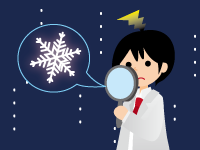



Although the way of generating is the same as rain, in the case of snow, it limits to when it is without melting when a cryohydrate finally falls from clouds, and it is thought that it snows. In order to become like this, it is considered as a standard, and unless it is quite low-temperature, over 5500 m, it does not generate with 3 ℃ or less 1500 m over -30 ℃ or less in -6 ℃ or less and the ground.

When it is loved as a phenomenon which symbolizes winter and snow carries out winter sports, such as skiing, it is required. Moreover, in the area where snow, such as Hokkaido, falls mostly, the festival "a Sapporo Yuki festival" of the art using snow is held, and an economic effect, such as being crowded with many people, is produced. However, if it rains too much not much, it will be accompanied by a traffic obstruction or the damage caused by a snowslide, and also it has big influence on industry or a life. Otherwise, when elderly people shovel away the snow from the rooftop, accidents are occurring frequently. It seems that moreover, it may become a snowslide and a flood since a thaw will take place if not only the damage of winter but spring comes.

In especially the latest thing, the Heisei 18 heavy snowfall is famous.From December, Heisei 17 to February, Heisei 18, this is what occurred focusing on the Sea of Japan side, and brought every place serious damage. With Aomori acid hot water, record was broken and it became the snow coverage of no less than 4.5 m. It suffered the damage in which a northeast, Hokkaido, and Hokuriku District were serious. It suffered much damage in other districts.Moreover, in Hachijo Island, it is imagined that it snowed in the wide range, such as becoming the snow coverage for the first time in 60 years.

